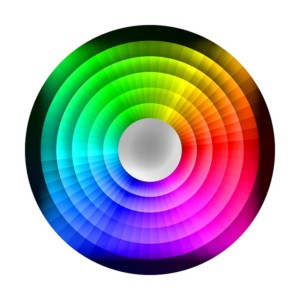
The Color Wheel
Color will always affect you whether you are aware of it or not. Even a color that is only slightly “wrong” has the power sabotage your natural coloring.
For years, before I studied color, there were certain days that people would ask me if I felt a bit sick and I was fine! Only later I realized what was actually going on was that the colors were affecting my skin and making me look ill! Being a redhead, I had been told to wear rust, but you can’t generalize about redheads – or any other type, look, or ethnicity. It must be individually determined.
Why is color a big deal? It’s a relatively serious matter because the wrong colors will give your skin a yellow, greenish, or gray cast. What this does, is it accentuates any circles, shadows, or wrinkles you might have. It visually brings out any blemishes or discoloration in your skin tone. The effect of this is that it makes you appear tired, ill, or older than you are.
The right colors enhance your natural coloring — giving a glow to your skin, making it look even, clear, and balanced. Your ideal colors add luster to your hair, shine to your eyes — making you look youthful, healthy, and radiant! Many people say they look 5 to 15 years younger in the correct colors. The right colors will balance visually and harmonize with you. Your natural energy will even seem to come out more wearing colors in your ranges. You are in harmony.
Many factors create overall look you express. Aside from the overall impression you make, the one single factor that has the strongest visual impact is determined by the color you are wearing. This is why it is critical to wear colors in your ideal range, and make sure they convey your intended message. When you’re feeling energetic and outgoing, colors in your dramatic ranges will put you in the spotlight in a positive way. When you’re in more of a quiet mood, you’ll be more comfortable wearing your neutrals.
You may be aware that color makes a big difference, but there’s a lot that isn’t clear. There’s a lot more to the color story than most realize. Here are a few things to know before you go out and get a typical color analysis. This will help you learn about color.
The Truth About Color
There is both art and science behind color, making it multi-dimensional and amazingly complex. However it is reasonably easy to understand once explained correctly. One fact that may surprise you: Scientists used to believe that there were 7 to 10 million colors. Now there a computer can generate 16.7 million color distinctions! Many of these are not suitable for clothing as they would not look good on anyone, but there are tens of thousands that can be worn.
Everyone can wear hundreds of colors well. It’s a matter of determining accurately which create positive and negative skin color changes. Needless to say, any approach that limits you to a few isolated colors is not going to work out well. You need your ranges of lightest to darkest, warmest to coolest, and brightest to dullest that are harmonious on you.
Color names are subjective — these names are a matter of opinion. Everybody has their own idea of what terms like “periwinkle blue” and “ruby red” actually look like. If I am lecturing to a group of art students on color, I might ask them to take out their paints and mix a color like “lemon yellow” or “royal purple.” If there are 20 students we will get 20 different paint swatches — different versions or interpretations of that color. Although color names are a matter of opinion, the qualities in colors can be described in art terms based on the amounts of pure color, black and white present in the mixture.
Commonly used color names are fine for describing the general color impression of the new dress you just bought to a friend. But with millions of subtly different variations of colors, it is not practical or logical to give them all names as a basis for identification. Color can be identified accurately only with a number that corresponds to the various color qualities present. For this reason a numbered, ordered, system is essential for organizing colors. Our system is based on the work of Albert Munsell. (https://en.wikipedia.org/wiki/Albert_Henry_Munsell)
Color terms are always relative. If someone says a color is “bright”, the obvious questions are, “How bright?” and “Compared to what?” A color can only be accurately referenced as light, dark, bright or dull when compared to another color that is either more or less so. That is why it is so important to have a specific point of reference for selecting colors when you’re shopping. This is why we give our clients a beautiful, extensive spectrum that they can put into their mobile device for easy reference.
Color is a continuum. One color will always blend into the one next to it in the spectrum. If you’ve ever taken art and mixed paints, you’ll remember that you can add one drop of another color and it changes the color slightly. So any divisions, categories, or groupings of color are artificial. For example, yellow will blend into yellow-green in very gradual steps. Since it is a continuum, there is no point at which it definitely stops being yellow and becomes yellow-green. However, if we wanted to, we could measure how many drops of yellow paint and how many drops of green paint are required to come up with the color of paint at any given point.
How Color Reacts and Relates To You
Color interacts with color. Since there are colors in your personal skin, hair, and eye coloring, these will be affected by the colors you wear. The effects always occur certain ways, it’s as predictable as gravity. The effects of color relationships are governed by scientific principles that are quantified and proven. The fact that color interacts with color in a consistent manner is the basis of the scientific principles of color interaction, which I will cover in another post. These principles explain the way in which any color will visually and discernibly change, when another color is placed next to it.
You are more important that your colors. The reality that color interacts with you is the first step in understanding why certain colors look better on you than others. Picture this, or try it: If you place a bright color next to a dull color, the bright color appears brighter, and the dull one, by comparison, duller. This same principle applies to human coloration. So, if you place a bright color next to a person with muted coloring it will overpower that person visually. It will draw attention to itself because of its brightness relative to the dullness of the person’s coloring. Another color can seem dull or faded next to a person with bright coloring. Two colors of equal brightness create an appearance of balance. Balance is what you want.
Avoid simplistic approaches and categories. Your optimal color range should be determined empirically by testing based on skin color reactions. I do not recommend any approach that just looks at you and says to wear some color category without adequate testing. (I was mis-diagnosed and given the wrong colors four different times before I found this approach.) I have an in-depth test testing process with many thousands of colors and specific protocol that we use for your analysis.
It takes testing for accuracy. Even an experienced analyst would have guess without testing and with no point of reference! It would be easy to jump to conclusions based on an initial impression. What matters is how the colors react with your specific coloring, and most importantly, how you look next to certain colors. I always worked in natural daylight and now use our virtual, computer-facilitated analysis process, still in natural daylight, to test hundreds of colors to find your best ranges.
Remember, you can wear hundreds of colors. All the colors that “work” on you will have certain common characteristics in color terms, in other words be similar in those ranges of light/dark, bright/dull, and warm cool. This makes perfect sense because they were chosen based on consistent criteria: YOU. I intend that my client have the optimal choices in their ranges.
My philosophy is that the person is more important than the clothing…and the purpose of your colors is to enhance you.
You need an extensive spectrum that expands your options. In other words, I want you to have at your disposal, not a few isolated colors that some approaches use. You need the widest range of colors that meet the standards for an “acceptable” color? What is an “acceptable” color? An acceptable color is one that is not so bright that it overpowers you visually. Again, this is due to the relationship of the brightness of the color compared to the brightness of the person. On the other hand, the color should not be so dull that the fabric looks old and faded. The color you wear should not create any undesirable skin color change, such as yellow, green, gray, brown, or red. (Sometimes it takes a trained eye to actually see this, but other people just think you don’t look so good.)
You and each one of us is naturally in harmony. Your skin coloring, eye, and hair coloring, are all in natural balance. Even your shapes and scale in your bone structure along with your skin and hair textures are in natural balance. Your personal color ranges for your Harmony Pattern were consistently selected to be positive and enhancing to every aspect of your look and energy.






